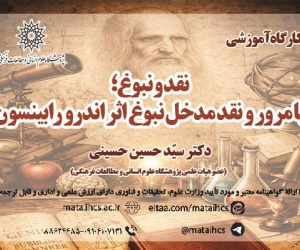جست و جوی هویت عروسک از منظر فلسفی (مقاله علمی وزارت علوم)
درجه علمی: نشریه علمی (وزارت علوم)
آرشیو
چکیده
حضور گسترده عروسک در همه اعصار از پیدایش بشر گرفته تا دنیای پست مدرن امروزی می تواند گواه وجود عروسک به منزله هویتی مستقل باشد. اما این ادعا برمبنای پرداختن به عروسک با رویکرد درزمانی است و به نظر می رسد مطالعات کافی در زمینه بررسی ابعاد هویتی آن با رویکرد هم زمانی وجود ندارد. همچنین، گاهی مرز میان اشیای صحنه، عروسک، و بازیگر در اجرا به حدی کم رنگ می شود که به سختی می توان عروسک را از آنان تفکیک کرد و به نظر می رسد استقلال هویتی او در سایه ای از تردید قرار دارد. هدف از مطالعه حاضر اثبات وجود عروسک به منزله هویتی مستقل است. روش تحقیق توصیفی، تحلیلی، و تطبیقی است و با استفاده از منابع کتابخانه ای. در این شیوه با درنظرگرفتن معانی هویت و با نگاهی به مسیری که فلاسفه (به ویژه ملاصدرا) در جهت احراز هویت موجودات استفاده می کنند و تطبیق این روش ها با عروسک وجوه خارجی، ذهنی، و رفتاری هویت عروسک تعیین می شود. سپس، به تحلیل و بررسی تشابهات و تمایزات این وجوه با اشیای صحنه و بازیگران پرداخته می شود. نتایج تحقیق بیانگر اثبات عروسک به منزله هویتی مستقل است. در این مطالعه الگویی متمرکز برای تشخیص هویت همه انواع عروسک ارائه شده است.The Search for Identity of Puppet by a Philosophical Approach
The widespread presence of puppets in all ages of human history, since the beginning of human existence to today's postmodern world, can prove the existence of the puppet as a historical identity. But this claim is based on addressing the puppet by a diachronic approach and it seems that there are not enough studies about aspects of its identity by a synchronic approach. While the puppet always has a lot of philosophical metaphors in regards to God, human existence, and the world, aspects of identity of the puppet has not yet been studied from a philosophical perspective. For this reason, it seems that the identity of the puppet as an independent entity has not been documented as such and therefore has not been viewed with this perspective. Also sometimes the boundaries between scene props, puppets, and actors in the time of performance are blurred in such a way that it is hard to identify puppets as the independent objects that they can be. Opinions of philosophers are the first and most obvious methods to determine the question of identity for objects or entities. Thus, we can adapt this perspective for puppet features in regards to the idea about identifying and determining the dimensions of puppet identity. In this article, by investigating the concept of identity and considering the way in which the Philosophers (especially Mulla Sadra) use that in order to identify all entities, we attempt to determine three aspects of puppet identity. They are: the objective existence, subjective existence, and behavioral aspects of puppet identity. The figure of the puppet represents the objectivity of it so we study the figure of the puppet as a deputy of its objective existence. After that, the behavior of the puppets are examined because it is intermediary between objective and subjective existence. In fact, the behavior makes the concept of the object transform into a puppet concept in the minds of the audience. The subjective existence of the puppet represents the form of the puppet in the mind of the audience and it assembles the concept of the puppet. In this part, an investigation into what is happening in the mind of an audience member when confronted with an object as a puppet. Whether this behavior is the essence of the object it indirectly infers to the animation and “acting” of the puppeteer. While these three aspects of identity are examined, we try to explore the similarities and differences of puppet identity against objects, scenes and actors because one of the most important things that form the identity of objects is finding their similarities among their groups and their differences with other objects. After examining the aspects of a puppet identity with regards to separation of the subjective existence from objective existence while the forma remain the same, we prove the puppet as an independent entity. Also, we point to audience psychological tendencies to animate an object. At the end, we consider three aspects of puppet identity and audience psychological tendencies for achieving a centralized model for identifying types of puppet identity aspects.









